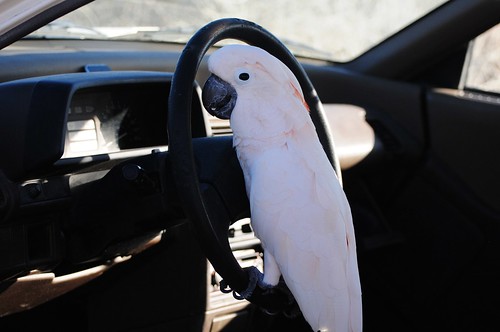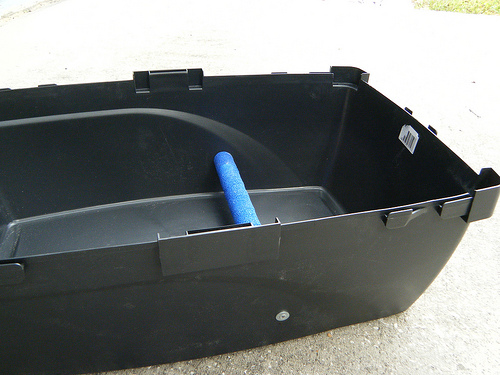
Moluccan cockatoo on the road
Summer is the time when many people choose to do their traveling. The children are free from school commitments and the weather is more likely to remain suitable for a road trip. Why not load the kids and the dog into the RV and head out across country?
For we parrot owners, though, decisions like those are more complicated: what do we do with the bird?
On the one hand, there is the fear of boarding. Not only do we assume that we will spend the entire vacation worrying about whether our bird is being looked after and kept well-fed and socialized, there is also the irrational fear that our birds will be angry with us when we return – or worse, will have forgotten about us during our brief absence from their lives.
The worrying always turns out to be for naught. Our birds are returned to us in fine health, and after a brief period of re-adjustment, they slide right back into the rhythm and routine of their home.
But here’s a thought: what if you were to bring the bird with you this year? Not only will it give your bird a chance to bond with everyone on the trip, it will provide countless opportunities to socialize your bird with new people, and will add to your bird’s growing repertoire of experience. What a fun adventure for everyone!
Of course, traveling with a bird is not as easy as traveling with the dog, but with a few special provisions, there is no reason your bird can’t make the trip to Grandma’s this summer.
The Cage
If you are traveling with a large parrot, obviously you will not be bringing the humongous cage from the living room along for the ride. I know that it is unthinkable for you to imagine your bird living out of a carrier or dog crate for the duration of the trip, but it actually works out just fine that way.
As it goes, a small cage or carrier is the best for road travel. In most cases, a smaller space provides a stronger sense of security for a bird – especially in a strange environment.
A smaller enclosure makes it easier to cover part or all of the carrier during travel (as your bird prefers) and it will be more convenient for you to move it around to cooler parts of the car as the sun changes position in the sky. There is the convenience of getting it into hotel rooms and it will allow you to take your bird with you when you need to make any stops that require leaving the car.

Perch is placed low in the carrier and is bolted from the outside
Perches
Your bird will be spending a lot of time in the carrier, so take the necessary time now to prepare it properly.
You will need to install a perch. While a bird can handle short trips standing on a flat carrier surface, it is an unnatural position for a bird’s feet to be in for a long duration of time and it would eventually become uncomfortable.
Select a wooden perch or dowel. Never use sandy or cement perches for travel – they are abrasive and will eventually irritate the skin on the feet. A cement perch is also too heavy to be placed in a lightweight enclosure like the one you will be using.
I select a perch diameter that is just slightly smaller than the sizes I use in the house cage to allow for good grip during bumpy travel and I wrap them with vet tape to add addition traction and comfort.
With plastic animal carriers, it is easiest to cut a wooden dowel to size and fasten it using a sharp wood screw that is drilled into the dowel from the outside of the carrier (see above photo).
If you are using a wire dog crate for travel, you can install a hanger screw to each end of a wood perch or dowel and attach it to the sides of the crate with washers and wing nuts (see hardware above). You could also notch each end of the perch and slide it onto the bars of the crate. In this case, I would further secure the perch from the outside with a staple gun.
Place the perch low in the carrier so that your bird’s head easily clears the roof of the carrier when on the perch. This is also a safety measure: should a bump during travel cause your bird to lose balance it will only be a single step down to the floor of the cage.
Accessories in the Carrier
Use plastic dishes that attach to the carrier door or crate sides so that your bird has constant access to water and dry food. Choose small, deep dishes that can hold a reasonable amount without taking up too much room inside the carrier.
If you feel must provide toys, avoid wood or plastic toys that could injure your bird by swinging into them and beware of anything that could cause entanglement. I find toys unnecessary because my birds become very engaged by the activities of the people in the car and the view from the windows.
Other Important Considerations
- Remain aware of your bird’s comfort level and cover the carrier when necessary. I promise that you do not ever need to experience a screaming parrot in a closed car.
- It is a good idea to secure the carrier or crate with a seat belt, but keep in mind that it may become a chew toy during travel so be careful of how you place the belt.
- Resist the urge to let your bird out into the car during the trip. As comforting as it might seem to have your bird on your shoulder while you drive, it is unsafe. A honking horn could frighten your bird into flight, causing you to take your eyes from the road or a sudden stop could cause your bird to clamp onto your ear in an effort to stay upright. Further, a parrot is a distracting sight for other drivers on the road. Don’t even make your bird aware that being out of the cage while in the car is an option. You may never again be able to have a peaceful ride with your bird in tow.
- If you are traveling with more than on bird, it is sometimes best to have them caged separately. Unforeseen stressors during the trip could result in aggression. Even if you feel very sure that your birds will handle travel well together, have enough carriers on hand to make the separation if necessary.
Arriving at Your Destination
Even though Grandma has assured you that bird is welcome at her house, she may not have fully understood what having a bird in the house entails. A bird can quickly become persona non grata when their novelty wears off and they start acting according to their nature. It would be great if you were able find room in the car for a tabletop play stand that will serve as a catch-all for food, poop and shredded toy pieces. (By the way, if you flip over many of the tabletop models you will see that the perch can be separated from the base, making them easier to pack).
It is also a good idea to agree upon a schedule for the bird (in cage time/out of cage time) and, if possible, designate a room where the bird can rest peacefully at night. The more effort you put into these matters now, the better the results will be for your bird, and ultimately you.
Recommendations
1) Make several travel test runs BEFORE your trip to see how your bird handles it. It is unusual, but some birds want no part of car travel. You don’t want to find this out 30 minutes into your big trip. Some birds also experience serious motion sickness, complete with vomiting, and a long journey could make this bird miserable. Practice trips that slowly increase in duration will let you know if your bird is up to a long journey.
2) Since you are taking steps to provide this great experience for your bird (and your family), go the whole distance and harness train him before you leave. This way, he can accompany you on sight-seeing trips and nature outings.
3) Pat yourself on the back for being a great bird owner!
Patty Jourgensen specializes in avian health, behavior and nutrition and has been working with and caring for rescue birds since 1987.



17 comments
Leave a comment